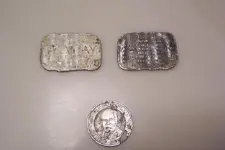Re: Camay Soap Tokens and Dr. Caldwell's Token
During the 1920s and 1930s, a number of manufacturers of bar soap and other soap products battling for brand supremacy employed the use of metallic tokens to entice consumers to buy their products.
Chief among the issuers were Procter & Gamble in Cincinnati, Colgate-Palmolive in Chicago (successor to Palmolive-Peet), and James S. Kirk & Co., a manufacturer of fine soaps in Chicago. The token campaigns were just one means by which the companies could advertise their products. Print, radio and television promotions were added to the sales initiatives.
Collectors seeking to acquire specimens of the tokens issued by the various soap companies should be aware that the tokens were produced in a variety of shapes and compositions, and each was valued differently and so stated on the token. Round, octagonal, unequal octagonal, four-point scalloped (cloverleaf), square (rounded corners) and rectangular (with opposite corners cut off) tokens are known. Many of the tokens are composed of aluminum, although specimens are known in brass, gilt brass, and white metal.
This oblong token in the shape of a bar of soap was issued by Proctor and Gamble to promote the perfumed Camay soap.
http://www.google.com/search?hl=en&ie=ISO-8859-1&q=Camay+"toilet+soap"++coupon&btnG=Search





